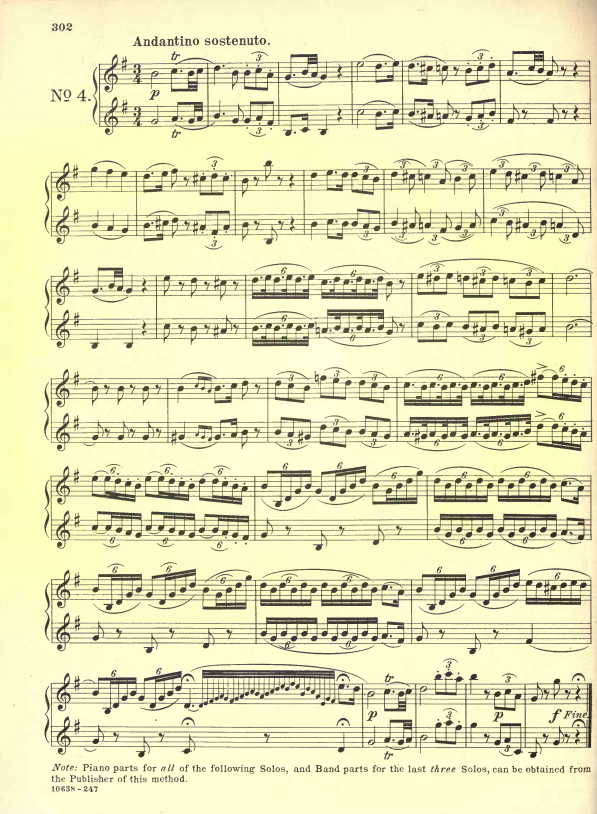Given we are all doing our part and social distancing right now, many of us are finding ourselves practicing more than we did before COVID-19 and social distancing became everyday words in our vocabulary. For anyone over a certain age, who ever took private lessons with a good teacher, or studied music at university, what I’m going to write about today it not new. That said, it might still be a good review.
Today’s article would be especially helpful for students who are currently in school—if schools were not cancelled worldwide—and who have band teachers who are so overwhelmed by the size of classrooms that they no longer have the ability to teach students the correct way to practice difficult passages.
When faced with a difficult passage or piece of music, what do you personally do?
- Try playing it at full speed 50 or more times until you give up.
- Trying playing it at full speed 50 or more times and say: Who cares, it’s good enough.
- Slow it down until you get most of it, and then practice up to speed again not caring if it’s 100% right.
- Play it note by note first, get those under your fingers first, then start at getting the speed up to where it should be by using a metronome.
Be honest now. I would say >90% of players are going to answer A, B, or C.
The correct answer is D. You should play a passage note by note first; and get all the fingerings under control. Then you turn on a metronome and play it really, really slowly and accurately. Once you can play it at that speed with 100% accuracy and precision, then you move the metronome up by 1 speed.
Now you go through the same process again. Work on your speed and accuracy. Once you’ve got it 100% perfect, bump up the speed on your metronome one more. And so on, and so on, and so on…
This will take time. It is quite likely that you will not be able to play something you are trying to play for the first time, at full tempo, perfectly in the first day. It is likely something you will have to work on. This is what practice is.
To help with this I have developed a practice schedule template that you can download. It is in Excel, and is fully editable. If you want to print it, it prints perfectly on a 8½ x 11 piece of paper. Just change the date of the starting week, and rest of the dates change as well. 😉
Break things down into smaller and smaller pieces
The trick is always to break things down into smaller, manageable bits. For example, if confronted with the following duet from Paul Deville’s, Universal Method For The Saxophone, regardless if you are playing the top or bottom line, it may likely be quite challenging at first glance. Many players are unlikely to be able to play this perfectly when they sight-read it.
If I was working with a student on this, I would play it with them bar by bar, line by line. I would go over bar 1 with them and help them work out the counting and notes—if those were problematic—then move on to bar 2.
I wouldn’t move onto the next bar until they played the one before it perfectly (or near perfectly in a lesson setting).
Once the student had the notes and timing under their fingers, and could play it perfectly, then I would increase tempo a bit, and start the line over again.
How to practice technical stuff at home
- Set the metronome tempo at about half speed. (The actual speed you set is dependant on how challenging the music is for you. The harder the music, the slower the speed.) 😉
- Work on each bar that gives you trouble until you have the notes, fingerings, and counting worked out perfectly. If you make a mistake, STOP, figure out the problem, and start the bar again.
- Move onto the next bar. Again get the notes, fingerings, and counting worked out perfectly. If you make a mistake, STOP, figure out the problem, and start the bar again.
- Once you’ve reached the end of the musical phrase, go back to the beginning of the phrase, and increase the metronome tempo by 1.
- Repeat steps 2-4 until you can play that phrase 100% correctly, 100% of the time, at full tempo (or pretty close to it). Then, and only then, move onto the next musical phrase.
- Keep practicing all the phrases you have mastered, and make sure they all flow seamlessly from one to another.
- Besides being technically correct, the bars that make up the phrases have to be musically correct. Pay attention to articulation, attacks and releases, dynamics, and so on, and so forth.




Hi Helen
Another excellent blog. Well done!
I have two points to add:
1. The concept of Plateau Learning. Excessive practice of one element is often counter productive. Practice until you’ve got as good as you can get on that piece and then move on/back to something else. Leave it for a day or so and then come back to it and you will find you can play it better than you could before. NEVER work on just one piece.
2. The design aspect of printed scores is never considered by the publisher (I bet the scores in your edition of De Ville are laid out just as they were a hundred years ago). Learning a new chart I will often transcribe it onto Noteflight and format it to suit my learning – giving more space to difficult sections. I can also listen to them.
3. In these days of lockdown NEVER start drinking before the sun has gone down. Your understanding of basic mathematics will go down the drain.
Best wishes
Joe
You brought up a very good point Joe—one that I should have mentioned. I never noted when to quit. Obviously there is a point in your practice time when you just move on from on piece of music to the next. I didn’t mention when that was.
The inclusion of the Excel chart was mentioned as a way to track your progression, but I didn’t mention how to use it properly. Sigh… My bad… Thanks for picking up on that. I need to fix that.
The DeVille duet I showed as example is just a .jpeg of the .pdf version that is available online. My personal copy is newer. 😉 That said, in principle I agree with what you’re saying.
I haven’t used Noteflight before, but I use Musescore—as do the majority of my students. Any music notation program like that could give the student (player) a way to enter the problematic bars and hear them played correctly. This is especially important if they don’t have a teacher.
As far as giving those problematic bars more space visually, that too can be a good idea depending on the complexity of the bar, the score itself, and your own individual learning style. I agree with you that copies of the really old method books are very hard to read.
Point in fact, the copy of 32 Etudes for Oboe and Saxophone by Ernest Loyon that I received from my teacher. It is awful to read. Through poking around online, I found a PDF version that was available since the copyright had expired. It is a much easier read. I know personally, I wouldn’t have the patience to enter the problematic bars, since for me, that would be almost the entire etude when I start working on it. 😉 —and there are waaay to many notes to do that. But for simpler, shorter stuff, that could be helpful for some players.
As for your third point: 😛 That’s simply no fun at all. 😉
Drinking after sunset has the disadvantage of a small time frame to loose the calories. The surplus energy of carbohydrates and alcohol are converted into fat during sleep.
I find it helpful to first listen to the piece being played properly, to get a feel for how it should sound, since I am not a strong sight reader. Then I tend to try playing the piece slowly to identify which are the bits that I find particularly tricky. Only then do I break it down into short phrases to work on individually. But I must confess that I am not very good at practising with a metronome!
Several teachers that I have come across do advocate starting at the end of a piece and mastering that, before going to the next to last section etc. – that way you are playing into parts that you do know well.
Thanks for the reminders
Yes, this is exactly what Theo just mentioned in his comment, and that I replied to. I use it when one of my students finds a particular section really challenging.
And although we are discussing it in reference to bebop, thank you for pointing out that it doesn’t matter what style of music you are practicing, this method works regardless.
When studying bebop I adapted method D with a small twist.
In long tricky passages it is difficult to keep the end of the phrase accurate.
So I studied some passages backwards by doing the last bars first before studying the whole phrase.
I am not share if it is a better system, but it works for me.
There are a number of things that I left out of this post, because I am planning on writing another article later. 😉 This is one of them. 🙂
Yup, I often start working at the end of a phrase—or written solo when working with one of my students—and get that nailed down first. Then I get the beginning locked in. Once those 2 are done, then we work on the middle section.
I have found this works quite well. Should I ever feel the urge to play through the Charlie Omnibook—true, I never did make it through the whole thing 😉 —then this is most certainly the method I would be employing myself.
Thanks for the reminder Helen.